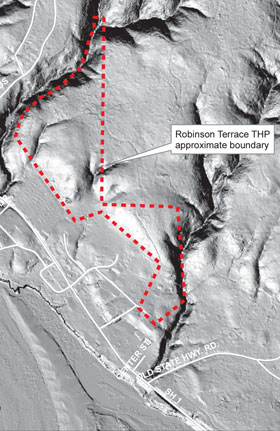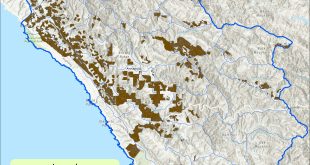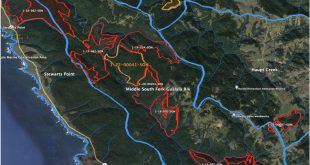THP 1-07-067 MEN
Table of Contents
- THP Overview map
- THP documents (annotated index)
- THP Quotes re: Development
- Gualala Town Plan & Zoning
THP Approval by CDF – 9/28/07
- Official Response to Public Comments
 0.3 MB pdf
0.3 MB pdf
Information sources
- THP Documents – CDF website
- Gualala Town Plan – County website
- Mendocino Coastal Zoning Code – County website
Letters
Timeline
5/18/07 Plan accepted for filing
6/12/07 Pre-harvest inspection
7/05/07 Second review team meeting
7/12/07 Gualala Municipal Advisory Council meeting 8/13/07 Plan revised and recirculated
9/12/07 Deadline for public comment (5:00 p.m. Pacific Time)
9/28/07 Plan approved by Dept. of Forestry
Description
The Robinson Terrace THP is 74 acres in size, located directly adjacent to and east of the town of Gualala.
It is distributed across two watersheds, Robinson Gulch and Big Pepperwood Creek. Water from the THP area enters one of two main watercourses, Robinson Gulch (which flows directly to the Pacific Ocean just north of the mouth of the Gualala River), and China Gulch (which flows directly into the Gualala River lagoon). The plan includes 37 acres of clear-cut (one in each watershed) and 37 acres of group and single selection.
The THP has limited road access points from public roads, therefore new road construction is necessary to reach timber along the southern plan boundary and for log landings at the top of the eastern unit. Approximately 1,200 feet of new road will be constructed. Harvesting has taken place as recently as 1988 on some portions of the plan.
Notes on topography and drainage
 Although the THP is named “Robinson Terrace” (emphasis added), the parcels include very steep terrace break areas. The two terrace breaks are immediately adjacent to and upslope from a mobile home park and the local medical clinic, respectively.
Although the THP is named “Robinson Terrace” (emphasis added), the parcels include very steep terrace break areas. The two terrace breaks are immediately adjacent to and upslope from a mobile home park and the local medical clinic, respectively.
The THP also includes Robinson Gulch and China Gulch, which are, as the names imply, narrow steep sided drainages. This highly dissected topography is typical of areas in close proximity to the San Andreas Fault System, where natural irregularities in fault geometry produce very rapid uplift and subsidence.
The THP is within 2,000 feet of the Pacific Ocean in the Robinson Gulch drainage, and within 1,000 feet of the Gualala River estuary (lagoon) in the China Gulch drainage. Excessive sediment and/or contaminants associated with timber harvest operations, or subsequent development, have ready access to the ocean and the estuary.
The fifty-year-old topographic base map understates the severity and generalizes the location of significant topographic features such as drainages and slope breaks. Newer (2004) and publicly available USGS data much more clearly shows the actual landscape. This newer and relevant information is needed both to insure adequate regulatory review and enable informed public comment.
Sediment runoff
The impacts of the proposed THP in aquatic habitats would occur as near-term indirect impacts of sediment runoff, and long-term cumulative indirect impacts (growth-inducing, subsequent project stages) of residential and commercial expansion of Gualala.
The China Gulch drainage (seasonal stream) discharges directly into the Gualala River lagoon. The lagoon is a winter estuary that is naturally closed to tidal circulation by a barrier beach for most months in spring, summer, and fall, making it highly sensitive to accumulated sediments or contaminant loads.
Significant sediment and contaminants (including nutrients from ornamental landscaping) would likely be generated by the THP itself and subsequent land use conversion, and these would be transported in runoff to the lagoon. China Gulch gradient is steep and includes no flat to gently sloping floodplain lands that could feasibly detain or filter sediments, or improve stormwater runoff quality.
Piecemealing?
The THP would eliminate mature coastal forest ground layer (forest floor) communities and habitat structure that can not be mitigated or regenerated within the foreseeable future.
This THP would likely cause a significant irretrievable and irreversible commitment of resources in favor of development, circumventing CEQA review while creating an impoverished environmental baseline for anticipated, proposed, foreseeable subsequent development proposals.
Timberland owner John Bower recently discussed development of the area for housing while giving a tour for the Gualala Municipal Advisory Council (see “Landowners host tour of upland Gualala” by Julie Verran in the August 25, 2006 edition of the Independent Coast Observer).
If Mr. Bower anticipates development of the property, he should be preparing a Development Plan with substantial public input (under CEQA) and submitting a timberland conversion plan to the Department of Forestry, rather than a simple timber harvest plan. However, the THP asserts that:
“No residential use is currently planned or anticipated for the THP area by the current landowners.”
– see THP Quotes re: Development.
 Friends of Gualala River Protecting the Gualala River watershed and the species living within it
Friends of Gualala River Protecting the Gualala River watershed and the species living within it



